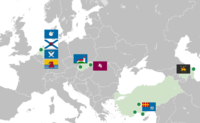Principality of Montescano
This article uses a non-standard infobox to display information. Please transcribe the information to a standard infobox appropriate for the article. |
Soeverein Vorstendom Montescano | |||||
| |||||
 Countries where territorial claims are located in light green | |||||
| Motto: "Nihil sine deo" Nothing without God | |||||
| National anthem: "Le retour des Princes Montescanesque à Paradis" | |||||
| Capital | Rietwyck | ||||
|---|---|---|---|---|---|
| Official language | Dutch | ||||
| Official religion | Chalcedonian Christianity | ||||
| Demonym | Montescanesque | ||||
| Government | Executive constitutional monarchy | ||||
| • Monarch | HH Prince Dionisiy I | ||||
| • Regent | Lord Christoffel van Achterbergen, Marquess of Goedeweg-Achterbergen | ||||
| • Grand pensionary | Lord Christoffel van Achterbergen, Marquess of Goedeweg-Achterbergen | ||||
| Legislature | Council of State | ||||
| Established | 29 May 2019 | ||||
| Population | 32 | ||||
| Currency | Florin | ||||
| CGSC | 4.2 (2020) high | ||||
| EPI | 3.9 (2020) medium | ||||
| Patron Saint | St. Demetrius of Thessaloniki | ||||
Montescano, officially the Principality of Montescano (Latin: Principatus Montescano; Dutch: Soeverein Vorstendom Montescano), was a landlocked state which claimed to be a sovereign state but was more commonly referred to as a micronation by external observers, with claims within the Netherlands and Slovakia. The Principality formally declared independence on 29 May 2019. Montescano was comprised of five counties, and had a population of 27.
Most of the political culture was based on the Medieval Low Countries as such much of its culture and many government positions revealed a Dutch influence on the nation. Unlike the Medieval Netherlands, Montescano upheld "Chalcedonian Christianity" as the official religion, which de facto meant that both the Roman Catholic and Eastern Orthodox denominations had an official status.
During the first months of its establishment the former Tsardom of Pavlov was officially disestablished and the Pavlovian Union was founded by the Treaty of Mykolayiv. In the following months Montescano saw some territorial instability with Nedland joining and shortly after leaving. After briefly restoring some of the Pavlovian legacy, upon the advise of numerous Counts the Tsardom of Montescano was proclaimed and the Pavlovian Union absorbed by Montescano. Within a month of declaring the Tsardom, the Monarch took action and appointed a Regent. The Regent restored the former culture and status citing the usage of manipulation for the Russophone changes.
Etymology

The etymological origin of Montescano comes from Tezdzhan, a part of the surname of the founder of Montescano. It was latinised to Tescano, Mon(t) was later added. The entire name could thus be translated to as "Mountain of the Tezdzhans".
History
Foundation
Montescano was founded in May 2019 by the former Pavlovian Tsar and Austenasian politician Dionisiy Tezdzhan-Smahin as a Sovereign Principality based on a fusion of Mediterranean and Germanic culture. The initial declaration of independence was written on 29 May 2019 and the same day the Statute, the basic law of the Principality was passed by the founders.
During the first months of its establishment the former Tsardom of Pavlov was officially disestablished and the Pavlovian Union was founded by the Treaty of Mykolayiv, with HH Sovereign Prince Dionisiy I being the Union's first President of the Council.
Gunderson affair
In June 2019, the Principality saw a huge expansion of territory with Nedland and numerous strips of land owned by acquaintances of the Monarch being annexed. Resulting in the Landtag having 6 members. HH Hereditary Prince Maurits, the full cousin of the Monarch was also offered the position of Heir presumptive and upon accepting he and his immediate family being granted Subjectship. Less than a month after the annexation of Nedland, a census was planned to establish who was still an active subject and who was not. Due to the great amount of inactive subjects who would otherwise have been removed from the subjectship roster, the Count of Nedland Edward Gunderson applied for independence to the Sovereign Prince. This was granted within numerous hours, resulting in all titles and honours attached to subjects registered in Nedland being declared null and void.
Rusification
In November 2019, the importance of the Dutch language and culture was officially recognised in the Principality. Dutch becoming the sole official language of Montescano, and the Landtag (a German term) being renamed to the Raad van State (English: Council of State). In the same month, Spaerenwoude was also annexed as the sixth county of the Principality, being the first time in 4 months a new territory has been annexed to the Principality. Two months later, when Lord Kristiian Karolovych Nevtonenko, Prince of Khatterask became a member of the Council of State, he proposed an act which established the Rus' culture in Montescano. This Act was approved, albeit not having unanimous support like most Acts in the Council of State have. The position of Grand Pensionary renamed to Posadnyk, and the Council of State albeit in English staying the Council of State being renamed to the Державна Рада in Old East Slavic.
On 2 April 2020 a new Statute was passed by the Council of State, declaring the Monarch as Tsesar of Montescano and changing the official name of the state to Tsardom. The discussions amongst the Council of State was not without controversy as between the Optimates and Pavlovian Strength numerous conflicts arised, with the Pavlovian Strength faction even going so far as to vote on reviving the Empire of Pavlov. The conflict calmed down after the Monarch vetod the proposal on reviving Pavlov. Shortly before the passing of the new Statute, Hasanistan and Khattrask were annexed by Montescano as crown dependencies.
Recent developments
After Hasanistan having seceded from Montescano in midst of conflict between the leaders of Montescano and Hasanistan, an internal issue started due to numerous members of the Council of State now being unable to hold their seat in the Council of State as a citizen of the "new" Hasanistan. Combining this with the recent changes to the Statute it was deemed by the Monarch that he was no longer capable of reigning over the Tsardom, and after a short vote in the Council of State Lord Christoffel van Achterbergen, Marquess of Goedeweg-Achterbergen was appointed the regent. After being declared the regent, Lord Christoffel enacted a decree revoking numerous controversial Acts of the Council of State and the Statute passed little less then a month earlier[1]. This led to the resignation of numerous high-ranking officials including Yaroslav Mar. Lord Christoffel proposed a new Statute to the Council of State, restoring the Principality in the same state as it was as in December 2019, albeit with 2 more territorial claims.
Governance and politics

Montescano was an Executive constitutional monarchy, under the rule of the Sovereign Prince. The government of Montescano was defined according to the Statute of 2020. The hierarchy of Montescano was divided into the Monarch, the Princely Family, the Grand Pensionary, the Council of State and the Montescanesque Nobles.
The Sovereign Prince was the highest authority in the Principality, the Monarch may approve and enact decrees and acts of the Council of State. On a daily basis the Monarch exercises few powers, with the Grand Pensionary exercising them in name of the Monarch. In Montescano, the Monarch rules based on his "divine right to rule" which can be seen from his title "by the Grace of God". Justification of the position of the Monarch could be drawn from the words of Richard I of England: "I am born in a rank which recognizes no superior but God, to whom alone I am responsible for my actions"[2] during his trial in Speyer. Likewise it also considers it a divine duty of all Christians, as in the New Testament, in which the first pope, St. Peter, commands that all Christians shall honour the Roman Emperor (1 Peter 2:13–20) St. Paul agreed with St. Peter that subjects should be obedient to the powers that be because they are appointed by God, as he wrote in his Epistle to the Romans 13:1–7. Likewise, Jesus Christ proclaims in the Gospel of Matthew that one should "Render unto Caesar the things which are Caesar's"; that is at first, literally, the payment of taxes as binding those who use the imperial currency (Matthew 22:15–22). Jesus also told Pontius Pilate that his authority as Roman governor of Judaea came from heaven according to John 19:10–11.
The Council of State was a legislative body that serves as the advisory body to the Monarch. It consisted of the Counts and Marquesses of the Principality and all appointed Secretaries. While holding serious reserve powers, the Monarch had till date never not granted assent to an Act of the Council of State. The Judiciary was under the control of the Monarch, with him having the sole authority to appoint and dismiss Judges. All sentences were carried out in name of the Monarch.
Members of the Council of State
-
HH Sovereign Prince Dionisiy I:
Monarch
Marquess of Tourkia
Count of Nieuwendam -
Lord Christoffel van Achterbergen, Marquess of Goedeweg-Achterbergen:
Grand pensionary
Marquess of Goedeweg-Achterbergen -
HH Hereditary Prince Maurits:
Heir presumptive
Count of Purmerland -
HH Princess-Consort Mariia:
Countess of Spaerenwoude -
Lord Tim van Norden, Count of Velsen:
Colonel of the Company of Riflemen Guards
Count of Velsen -
Lord Äshgär Rzayev, Count of Komstad:
Sénéchal
Count of Komstad -
Lord Christian Newton, Marquess of Kaap Hatteras:
Marquess of Kaap Hatteras
Connétable -
Lord İsmetcan Saraç, Baron of Anemorion:
Grand Chamberlain
Representative for Tourkia -
Lady Lenka Kiernosz, Countess of Horne:
Countess of Horne
Private Secretary of HH
Administrative divisions

The main form of first-level administrative subdivision in Montescano was the county or the march. Counties were intended to encompass any Montescanesque territories, whether contiguous or not, resting within the same square mile of land and water. In counties where not all territory was contiguous, each portion of land was a barony, with smaller territories being grouped together to form baronies. Every permanently populated barony was considered a town, and may enact its own local laws through a direct vote of its residents or the Baron.
The Barony of Rietwyck, part of the County of Spaerenwoude was the capital city in the Principality. Most of the Barony's area was occupied by the Princely Palace where the Princely family resides and work as the government body. The County of Goedeweg-Achterbergen consisted of a large lake, a farm field and a winefield. The County of Purmerland consisted of the Château in which the heir presumptive lives.
| Flag | Coat of Arms | Name | Code | Annexed | Pop. | Administrative center | Noble | Representative |
|---|---|---|---|---|---|---|---|---|
| Marches | ||||||||

|

|
Goedeweg-Achterbergen | GOE | 29 May 2019 | 3 | Achterbergen | Marquess Lord Christoffel van Achterbergen, Marquess of Goedeweg-Achterbergen | |

|

|
Tourkia | TUR | 13 May 2020 | 5 | Attaleia | Marquess HH Sovereign Prince Dionisiy I |
Lord İsmetcan Saraç, Baron of Anemorion |

|

|
Kaap Hatteras | HAT | 15 May 2020 | 3 | Rustenburg | Marquess Lord Christian Newton, Marquess of Kaap Hatteras | |
| Counties | ||||||||

|

|
Nieuwendam | NIE | 29 May 2019 | 3 | Waterland | Count HH Sovereign Prince Dionisiy I | |

|

|
Purmerland | PUR | 18 July 2019 | 3 | Ilpendam | Count HH Hereditary Prince Maurits | |

|

|
Spaerenwoude | SPA | 26 November 2019 | 2 | Rietwyck | Countess HH Princess-Consort Mariia | |

|

|
Velsen | VEL | 8 January 2020 | 4 | IJmuiden | Count Lord Tim van Norden, Count of Velsen | |

|

|
Komstad | KOM | 3 February 2020 | 1 | Salm | Count Lord Äshgär Rzayev, Count of Komstad | |

|

|
Horne | HOR | 8 May 2020 | 1 | Nieuwkoop | Countess Lady Lenka Kiernosz, Countess of Horne | |
Law and Order
The Princely Guard was responsible for both military tasks and law enforcement. Jurisprudence operates on a civil law legal system, crimes being tried before a County Court or the Princely Court, depending on the severity of the offence and if it was restricted to a certain County. Due to extreme low number of crimes committed, there were no permanent courts, instead being summoned upon a person being charged with a crime. Civil disputes were resolved in a County Court, with the possibility of an appeal before the Princely Court being there.
The Princely Guard consisted of two regiments, I Regiment Prince’s Company of Riflemen Guards, acting as standing military of the Principality, and the II Regiment Princely Maréchaussée, acting as gendarmerie and handling all police duties. There were 5 members of the Princely Guard before the dissolution of Montescano.
Foreign Relations
The foreign relations of the Montescano were implemented by the Secretary of Foreign Affairs. The power to grant official diplomatic recognition of sovereignty lies primarily with the Monarch, but was made on the advise of the Council of State. Although Montescano was not internationally recognized by any member of the United Nations, it does hold (in)formal diplomatic relations with various micronational entities. Montescano's foreign relations were influenced by the official foreign policies of Montescano. Montescano was a member of the Pavlovian Union.
Full diplomatic relations
 Republic of Ashukovo, since 23 April 2020
Republic of Ashukovo, since 23 April 2020 Empire of Austenasia, since 3 January 2020
Empire of Austenasia, since 3 January 2020 Kingdom of Brienia, since 4 May 2020
Kingdom of Brienia, since 4 May 2020 Gymnasium State, since 25 June 2019
Gymnasium State, since 25 June 2019 Kingdom of Imvrassia, since 4 December 2019
Kingdom of Imvrassia, since 4 December 2019 Karnia-Ruthenia, since 1 August 2019
Karnia-Ruthenia, since 1 August 2019 Federal Republic of Lostisland, since 20 Jan 2020
Federal Republic of Lostisland, since 20 Jan 2020 Confederation of Mahuset, since 5 June 2019
Confederation of Mahuset, since 5 June 2019 Nedland, since 28 April 2020
Nedland, since 28 April 2020 Nedlando-Khorașanese Union of Former Colonial Possessions, since 3 July 2019
Nedlando-Khorașanese Union of Former Colonial Possessions, since 3 July 2019 State of Zenrax, since 3 July 2019
State of Zenrax, since 3 July 2019
Economy
The Principality had a tiny market economy, regulated by the Chamber of Commerce itself a part of the chancellery. The only company operating in Montescano is the Vorstelijke Mar D'Israeli van Royan Bank (for 66% owned by the Montescanesque monarchy). The currency of Montescano was the Florin, which wass also used by other states of the Pavlovian Union. Montescano was completely reliant on imported goods and services provided by the Netherlands, Slovakia and the UK.
The only active sector in Montescano was the IT sector and a e-banking solution for the Montescanesque Florin.
Culture

The Montescanesque culture was largely influenced by the Italian, French, Dutch and Western-Turkish Culture. These great european influences made the Montescanesque culture a romantic and flattering influence in the micronational world. Montescanesque people, practice a serious form of Chalcedonian Christianity in various denominations. There wass also a Sunni Muslim minority in Montescano.
Cuisine
The national food of Montescano is the Mushroom Lasagne, it was often the mais course in celebratory days, such as Christmas and court dinners. Other traditional dishes are Cannelloni and all types of pasta and sauces. In the Spring and Summer, many Montescanesque people enjoy a Rakı Sofrası which is a traditional Western Turkish feast consisting of a lot of Meze and Rakı a sweetened, anise-flavoured, alcoholic drink.
Religion
While the Statute officially didn't stipulate an official religion, due to the restriction on the Monarch being a Christian baptised in the holy trinity and all holidays of the One, Holy, Apostolic and Catholic Church being recognised, it was widely accepted that Chalcedonian Christianity is the state religion.
Public holidays
The Principality celebrated fourteen public holidays each year, many of which are Christian feast days. Public holidays were officially defined in 1 Dion. al. 11 (State Holidays act).
In regards to the several holidays which were dated in relation to religious holidays, local authorities decide whether to observe the holiday in relation to Western (Catholic), Eastern (Orthodox), or both. The religious holidays mentioned here were in the Gregorian equivalents of the Julian dates.
| Date | Name | Type | Notes |
|---|---|---|---|
| 1 January | New Year's Day | Secular | Celebrated as start of the new year, usually the Princely family takes a trip abroad. |
| 5 January | Christmas Eve | Religious | Celebrates the traditional birthday of Jesus. |
| 19 January | Theophany | Religious | Traditional commemoration of the baptism of Jesus. |
| 25 March | Feast of the Annunciation | Religious | Commemoration of the visit of the archangel Gabriel to the Theotokos, during which he informed her that she would be the mother of Jesus. |
| 19 April (2020 date) | Easter | Religious | Celebrated the resurrection of Jesus. |
| 28 May (2020 date) | Feast of the Ascension | Religious | Commemoration of the Ascension of Jesus into heaven. |
| 29 May | Day of Montescano | Secular | Celebrating the birthday of the Principality |
| 7 June (2020 date) | Pentecost | Religious | Celebrates the descent of the Holy Spirit upon the Apostles and other followers of Jesus. |
| 14 June (2020 date) | Feast of All Saints | Religious | Commemoration all saints collectively. |
| 12 July | Feast of Saints Peter and Paul | Religious | Commemoration of the anniversary of their death. |
| 28 August | Feast of the Assumption | Religious | Commemoration of the bodily taking up of the Theotokos. |
| 17 October | Prince' Day | Secular | Birthday of the Sovereign Prince |
| 26 October | Feast of Demetrius of Thessaloniki | Religious | Feast of Demetrius of Thessaloniki, the Patron saint of Montescano |
| 9 December | Feast of the Immaculate Conception | Religious | Celebrates the immaculate conception of the Theotokos. |
References









